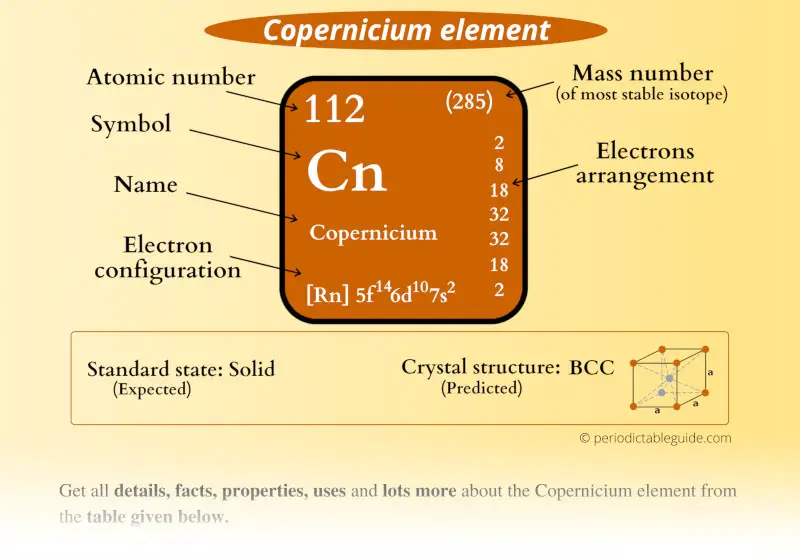
This is a SUPER easy guide on Copernicium element.
In fact, the table mentioned below is the perfect information box (Which gives you every single detail about the Copernicium element in Periodic table.)
So if you want to know anything about Copernicium element, then this guide is for you.
Let’s finish this very quickly.
Copernicium Element (Cn) Information
| State (at STP) | Liquid (predicted) |
| Position in Periodic table | 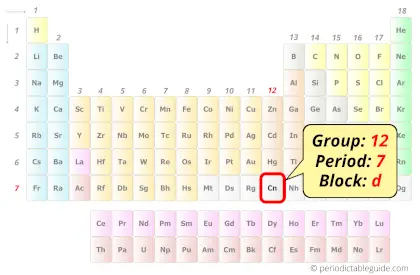 Group: 12, Period: 7, Block: d |
| Category | Synthetic element |
| Atomic number or Protons | 112 |
| Electrons | 112 |
| Symbol | Cn |
| Atomic mass of Copernicium (most stable isotope) | 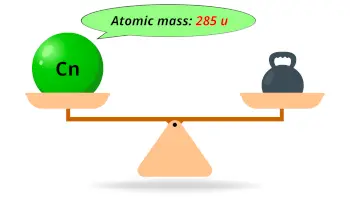 285 u |
| Electrons arrangement or Bohr model | 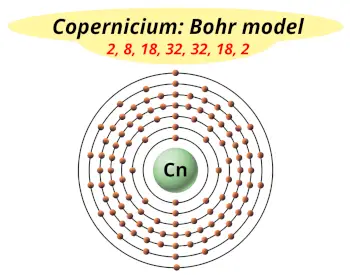 2, 8, 18, 32, 32, 18, 2 |
| Electronic configuration | [Rn] 5f14 6d10 7s2 |
| Crystal structure (predicted) | 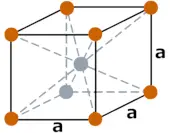 BCC (body centered cubic) |
| Density | 14 g/cm3 |
| Main isotope | 285Cn |
| CAS number | 54084-26-3 |
Copernicium in Periodic table
Copernicium element is in group 12 and in period 7 of the Periodic table. Copernicium is the d-block element and it is a radioactive synthetic element.
| H | He | ||||||||||||||||
| Li | Be | B | C | N | O | F | Ne | ||||||||||
| Na | Mg | Al | Si | P | S | Cl | Ar | ||||||||||
| K | Ca | Sc | Ti | V | Cr | Mn | Fe | Co | Ni | Cu | Zn | Ga | Ge | As | Se | Br | Kr |
| Rb | Sr | Y | Zr | Nb | Mo | Tc | Ru | Rh | Pd | Ag | Cd | In | Sn | Sb | Te | I | Xe |
| Cs | Ba | La* | Hf | Ta | W | Re | Os | Ir | Pt | Au | Hg | Tl | Pb | Bi | Po | At | Rn |
| Fr | Ra | Ac** | Rf | Db | Sg | Bh | Hs | Mt | Ds | Rg | Cn | Nh | Fl | Mc | Lv | Ts | Og |
| *Ce | Pr | Nd | Pm | Sm | Eu | Gd | Tb | Dy | Ho | Er | Tm | Yb | Lu | ||||
| **Th | Pa | U | Np | Pu | Am | Cm | Bk | Cf | Es | Fm | Md | No | Lr |
←Move to: Roentgenium (Rg) element – Periodic Table
→Move to: Nihonium (Nh) element – Periodic Table
Why is Copernicium in Period 7?
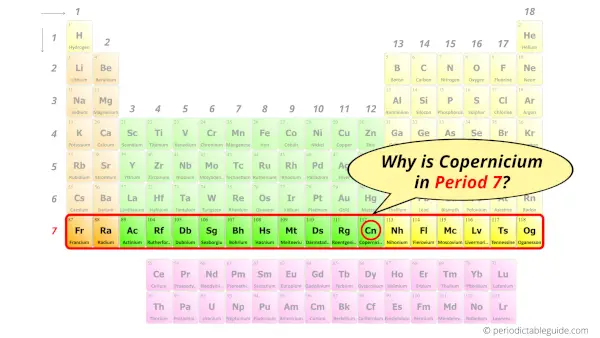
Let me ask you a question.
How many shells does a copernicium atom have?
It’s 7. Right?
You have already seen the bohr model of copernicium atom in the above table.
From the Bohr model, it can be found that the number of orbits or shells in copernicium is 7. Hence, as copernicium has 7 orbits, it lies in period 7 of the Periodic table.
Why is Copernicium in d-block?
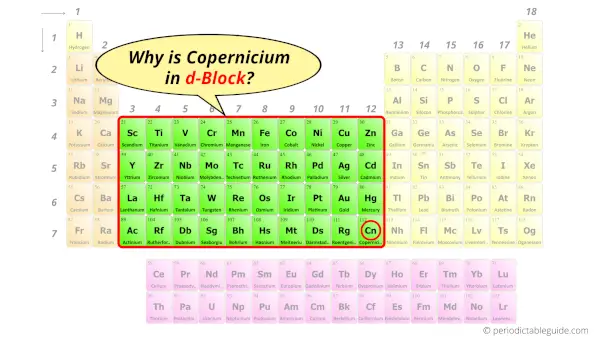
Before knowing this reason, first of all I want to ask you a simple question.
How can you determine the blocks-wise position of elements?
The simple answer: The elements will lie in the s, p, d or f block will completely depend upon the subshell in which the last electron will enter.
For example; the electron configuration of copernicium is [Rn] 5f14 6d10 7s2.
So the last electron of copernicium enters the d-subshell or d-orbital.
Hence, copernicium is the d-block element.
5 facts about Copernicium
Interesting facts about copernicium element are mentioned below.
- The element was given the name “Copernicium” to honor the scientist Nicolaus Copernicus.
- Copernicium was discovered by Sigurd Hofmann and his colleagues in 1996.
- Copernicium is not available naturally and it is artificially prepared in a laboratory.
- There are 7 known isotopes of copernicium and all those isotopes are radioactive in nature.
- The most stable isotope of copernicium is 285Cn, which has a half life of 28 seconds.
Properties of Copernicium
The physical and chemical properties of copernicium element are mentioned below.
- The copernicium element is extremely radioactive and has a very short half life.
- The calculated atomic mass of the most stable isotope of copernicium is 285 u and its calculated density is 14 g/cm3.
- The copernicium is predicted to have liquid phase at STP.
- The predicted crystal structure of copernicium is BCC (body centered cubic).
- The most stable oxidation state of copernicium is predicted to be +2. Besides this, it can also show +4 oxidation state.
Uses of Copernicium
Copernicium is generally used for scientific research work. Copernicium has no commercial use due to its scarcity and radioactivity.
Explore our New Interactive Periodic Table (with Rotating Bohr Models and More)

Details about this Periodic table:
- Access detailed info on all elements: atomic mass, electron configurations, charges, and more.
- View rotating Bohr models for all 118 elements.
- Get a free HD image of the Periodic Table.
Note: For future use, bookmark this Periodic table or visit “PeriodicTableGuide.com”
External resources:
- Copernicium – Wikipedia. (2018, April 21). Copernicium – Wikipedia. https://en.wikipedia.org/wiki/Copernicium
- Copernicium – Element information, properties and uses | Periodic Table. (n.d.). Copernicium – Element Information, Properties and Uses | Periodic Table. https://www.rsc.org/periodic-table/element/112/copernicium
- P. (n.d.). Copernicium | Cn (Element) – PubChem. Copernicium | Cn (Element) – PubChem. https://pubchem.ncbi.nlm.nih.gov/element/Copernicium
- It’s Elemental – The Element Copernicium. (n.d.). It’s Elemental – the Element Copernicium. https://education.jlab.org/itselemental/ele112.html
- Periodic Table of Elements: Los Alamos National Laboratory. (n.d.). Periodic Table of Elements: Los Alamos National Laboratory. https://periodic.lanl.gov/112.shtml
- Hofmann, S. (2010, February). Welcome copernicium? Nature Chemistry, 2(2), 146–146. https://doi.org/10.1038/nchem.533
